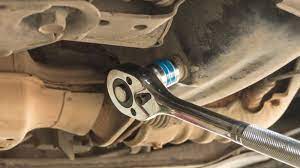How to get a stuck oil drain plug out; when I learned how to change my oil, the first time I did it, I thought it was going to be a breeze. In reality, however, it wasn’t quite as easy as the YouTube video made it seem. After spending hours attempting to remove my drain plug with no luck, I was ready to give up on this whole car thing altogether. But then I realized that there were other ways that I could remove that stubborn piece of metal from inside my engine and get back on track with changing my own oil (and saving money while doing so).
- Warm up the oil.
- Heat up the oil. This is generally done with a heat gun, blow dryer or small torch. Do not use an open flame or boiling water as it can cause damage to your car and its components. Using hot water could also cause contamination inside the engine when it cools down again. You can also use a hairdryer on high heat but do so carefully to avoid scorching the paintwork or rubber seals around the drain plug hole in particular.
- Apply penetrating lubricant.
You can use a penetrating lubricant, such as Liquid Wrench or WD40. Apply the lubricant directly to the plug and let it sit for 15 minutes before trying again to remove it. If this doesn’t work, repeat this step again and try loosening the drain plug after waiting another 10 minutes if needed.
- Remove any rust with an abrasive pad.
If you are dealing with rust, then you should try to remove it first. If you have a wire brush, use that to clean away as much rust as possible from the drain plug and around its threads. You can also use sandpaper or a wire brush with lubricant to do this.
- Break it loose with a hammer and screwdriver.
This is the most aggressive method, and you should only use it as a last resort.
- Use a hammer and screwdriver to loosen the drain plug.
- Place the tip of your screwdriver into the drain plug, then tap it gently with your hammer until you feel it catch on something inside the plug. You may need to go back and forth between tapping and trying to turn with your wrench in order to break loose whatever is preventing you from removing it. If you’re unable to find anything that will slow down enough for you to turn by hand, try applying gentle pressure first before hitting hard enough for your tool’s tip to get caught on something inside. The idea here is not so much about breaking through whatever has gummed up this process (though sometimes this happens), but rather loosening and clearing out any debris from around where things are stuck together so that further attempts at removal will be easier–and less likely–to damage either part or cause injury while doing so
- Screw the drain plug back in and then out again.
If the plug is jammed in tightly, use a hammer and screwdriver to break it free. Do not attempt to drill or use a power tool, they could damage your drain plug or oil pan. If you’re trying to unscrew a stubborn drain plug with a standard wrench, place the end of your wrench onto the inside lip of the drain plug itself instead of on top of it. This will allow you more leverage and help prevent rounding off this piece’s corners.
In addition to these tricks, remember that patience is key when dealing with stuck oil pans or drain plugs. If at first you don’t succeed (and you probably won’t), take some time off before attempting again; let your frustration cool off while working on something else for a while!
- Use a broken spark plug extractor if other methods don’t work.
If you’ve tried the other methods and still can’t get your oil drain plug out, it may be time to bust out a broken spark plug extractor. A rusty, jammed-in oil drain plug is usually more difficult to remove than one that has been in place for many years. The reason for this is because the old one has worn down over time and become loose. However, a new one installed by the manufacturer will tend to be harder to remove until it gets worn down some more and becomes easier to pull out with repeated use. Read Also : Symptoms of Bad Spark Plug
If you have an overhead valve engine model or a flathead engine model (which are also known as side valve), this method may work best for your vehicle. It involves removing the head of your car or truck’s engine so that there will be no interference from any other part inside of it such as valves or pistons which would prevent you from using any regular tools like those listed above on its oil drain plug itself without damaging something else internally within its cylinder block first before attempting extraction attempts upon removal effort alone without destroying things like gaskets while doing so!
If you can’t get the oil drain plug out, start by soaking it in penetrating lubricant and trying to loosen it with multiple tools before turning to more drastic measures like a broken sparkplug extractor.
- If you can’t get the oil drain plug out, start by soaking it in penetrating lubricant and trying to loosen it with multiple tools before turning to more drastic measures like a broken sparkplug extractor.
- If you’re having trouble loosening your drain plug, first use a penetrating lubricant such as WD40 or PB Blaster to reduce friction between the threads of your wrench and the nut that holds down the drain plug. Once you’ve gotten enough lubricant on there, try using a hammer and screwdriver (or any other long metal object) to tap around until you feel some give. The force of tapping may break off pieces of rust or other corrosion that was keeping everything stuck together; if this happens, don’t worry! It’s just parts of your old oil filter breaking off inside your engine block while they’re being dislodged from their place where they were trapped under all those years of buildup!
If none of these methods work for you then try using an impact wrench instead—it might take a few tries but eventually one should come loose.
Conclusion
If you’re still having trouble getting the oil drain plug loose after trying all these methods, there are a few more options. You can try using a 3/8-inch drive breaker bar and socket (a long extension may be helpful), or a ½-inch drive breaker bar and socket. If neither of those works, you may need to use an oil filter wrench or even a chain wrench. However, these will destroy the engine if used improperly so make sure that your car is parked on level ground with the wheels chocked before attempting this method!







